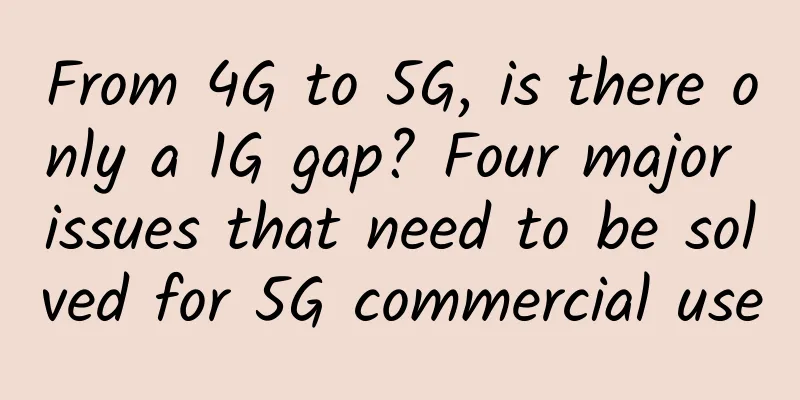From 4G to 5G, is there only a 1G gap? Four major issues that need to be solved for 5G commercial use

|
Recently, the State Council issued the "Guiding Opinions on Further Expanding and Upgrading Information Consumption to Continuously Release Domestic Demand Potential", proposing to fully release domestic demand potential, deploy the expansion and upgrading of information consumption, accelerate the fifth-generation mobile communication (5G) standard research, technical trials and industry promotion, and clearly stated that it will strive to launch 5G commercial use in 2020. In fact, in addition to China, many countries around the world have released 5G roadmaps: Russia has always regarded 5G development as one of its priorities. According to the plan, the first batch of 5G users will appear in the capital Moscow in 2021; the British government announced its 5G development strategy in March 2017; in addition, South Korea intends to take the lead in using 5G communications during the 2018 Winter Olympics; and as the host of the 2020 Tokyo Olympics, Japan plans to officially provide 5G communication technology services in 2020... Just as everyone is ready to embrace the 5G era with open arms, has anyone ever thought about whether 5G is really that easy to implement? Is there only a 1G gap from 4G to 5G? The answer is obviously no. In fact, the commercialization of 5G technology still faces multiple challenges.
It is still difficult to unify global communication standards Industry standards have always been a headache for many emerging industries, and 5G, the next generation of communication technology, is no exception. In July this year, China, the United States, Europe, Japan, and South Korea will unify communication standards around the next generation of ultra-high-speed wireless communication 5G technology, and plan to reach an agreement on frequency standards around 2020 in order to popularize common equipment and related products in the global market. However, in order to compete for the communications industry and out of considerations of national interests, the 5G standard will inevitably cause a big competition during the unification process. Who doesn't want to take the initiative and occupy a dominant position in the 5G market? From this point of view, the unification of global communications standards may still have a long way to go. Spectrum resource shortage problem still exists As we all know, in the field of mobile communications, spectrum resources are the core resources that drive industrial development. For now, although Xiaolingtong has made way for operators' 4G spectrum at a faster pace, the spectrum resource problem has not been completely solved. With the advent of the 5G era, the market demand for spectrum resources will continue to grow, and the shortage of spectrum resources will become more serious. Data shows that my country's spectrum demand is expected to reach 1490MHz-1810MHz in 2020; considering that the potential candidate frequency bands for IMT in the future mainly include 3300-3400MHz, 4400-4500MHz, 4800-4990MHz and 3400-3600MHz, it is not difficult to see that the contradiction between supply and demand of spectrum resources in the 5G era will be more prominent. The contradiction between high investment and slow return Earlier, Morgan Stanley listed China Mobile and China Unicom as "not recommended investment stocks among Asian telecom stocks" because "the capital investment in 5G business is too large and its return rate is low." Indeed, to meet the needs of the 5G era, operators will adopt higher frequency bands and nationwide spectrum, which will undoubtedly significantly increase capital investment. Morgan Stanley predicts that China Mobile's capital expenditure will reach 480 billion yuan between 2019 and 2023. Since 5G is not expected to be commercialized quickly after 2020, China Mobile's internal rate of return will eventually be lowered. At this stage, the contradiction between investment and return is obviously difficult to reconcile. Some companies will be more cautious about 5G investment, or even withdraw and wait and see, which is not conducive to promoting the rapid growth of 5G. Faster speeds bring higher data rates Putting aside the above technical and financial issues, for the majority of users, 5G charges are obviously what they are more concerned about. While 5G brings faster network speeds and higher communication quality, will the price soar? It is important to know that the construction of 5G base stations requires a large amount of capital investment. From this point of view, the data charges will not only decrease but not increase as many consumers expect. Moreover, for operators, increasing data charges can improve performance and achieve greater profits. However, with the approach of 5G and the intensification of market competition, operators will not only increase investment in technology and funds, but will also reduce prices to win more market share. From this point of view, the growth rate of 5G tariffs in the future will not be too large, and the problem of soaring costs will not exist for a long time. |
<<: Li-Fi is 100 times faster than Wi-Fi. Is it reliable?
>>: Blockchain from an economic perspective
Recommend
BuyVM: AMD Ryzen KVM small amount of restocking starting at $3.5/month, 1Gbps unlimited traffic, Las Vegas/Luxembourg, etc.
BuyVM's low-end VPS packages are currently be...
From rough to soft decoration: 5G R17 standard officially frozen
After many twists and turns, the 3GPP R17 standar...
Application of Self-Organizing Network in IOT Devices
Labs Guide In recent years, IoT devices have been...
Zhang Xuezhi from the Ministry of Industry and Information Technology: We will continue to support all parties in the industry to jointly promote the development of 5G applications
[[411408]] From July 13 to 15, the 2021 China Int...
OneTechCloud VPS hosting 20% off, Hong Kong CN2/CMI large bandwidth/US CN2 GIA/high defense, etc.
OneTechCloud has updated this month's discoun...
WOT Xu Dongchen: JVM-Sandbox Non-intrusive runtime AOP solution based on JVM
[51CTO.com original article] On May 18-19, 2018, ...
Operators competing in the digital service market for SMEs are facing opportunities for transformation and development
Recently, the Ministry of Industry and Informatio...
The story behind 2.5 million 5G users in 5 months
[[275646]] South Korea's 5G development speed...
Kvmla: VPS hosts are 20% off, old users can get 100 yuan for 500 yuan, Singapore dedicated servers start from 350 yuan/month
Kvmla has launched a year-end and 2024 New Year p...
Data Center Container Network Technology
Container technology is very popular and often me...
Operators have confirmed: The first generation of 5G mobile phones can only use 4G networks
Recently, the inability of NSA 5G phones to conti...
How SD-WAN as a Service Addresses MPLS Limitations
While MPLS has served enterprises well for many y...
RackNerd: Multi-data center VPS annual payment starts at $10, place an order to win a random blind box and get a discount
RackNerd has launched the 2022 Black Friday promo...
Clouveo: $3.5/month KVM-1GB/15G NVMe/2TB/Los Angeles Data Center
You may not be familiar with Clouveo. It is a sit...
TCP/IP protocol family architecture--network communication
Computers and network devices need to follow the ...









